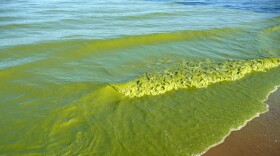Researchers say Lake Erie’s cyanobacteria problems could get worse if the only goal is to reduce phosphorus.
The harmful cyanobacterial blooms that produce toxins are fed by phosphorus, primarily from agricultural runoff.
Scientists from the University of Michigan and Technische Universität Berlin used field data and computer modeling which predicted if you only reduce phosphorus, cyanobacteria will turn to another nutrient, nitrogen. That could mean fewer cyanobacterial blooms, but higher amounts of toxins.
The research is not indicating that stopping the effort to reduce phosphorus is the solution.
“We hope it’s not going to be misunderstood, that people think that we shouldn’t do anything,” said Ferdi Hellweger from TU Berlin.
He said people actually need to do more.
“We're saying very clearly in the paper that a dual nutrient management strategy is the right approach. So you should reduce phosphorus and nitrogen together.”
Both nutrients are used to fertilize crops.
The research was published in the journal Science. A University of Michigan news release with more information can be found here.





